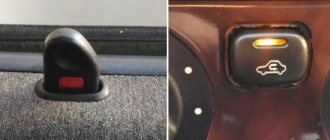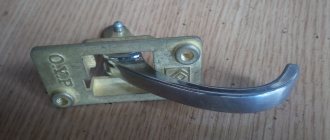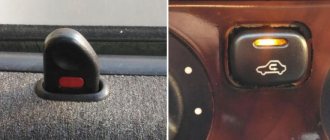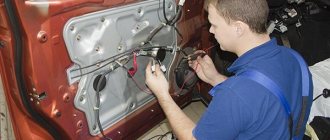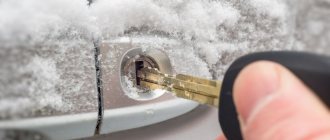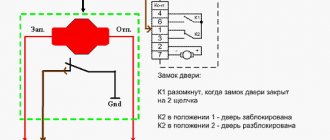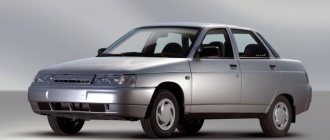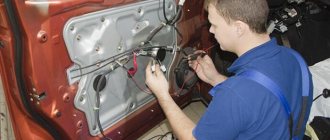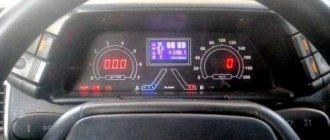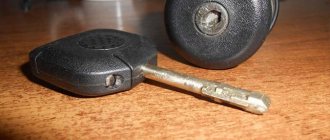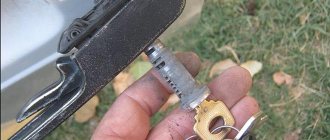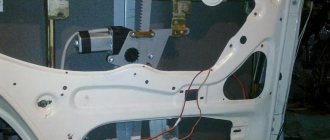The VAZ-2112 central lock is considered a fairly safe device for the owner of this car. Keeping pace with progress, a person strives to be in time everywhere. This type of transport, such as a car, has long become not a luxury, but a means of transportation. According to statistics, every second person drives a car.
Doesn't work Where is the Fault Diagram
Does not work
The central locking motor may not work for a number of reasons:
There was a break in the winding near one of the poles.
If the supply voltage is applied for more than one second, the collector will heat up and after the end of movement, the hot collector leads to the melting of the plastic under its plates. Because the brushes are spring-loaded, they begin to connect, squeezing out the molten plastic, and when the brushes connect, the central locking power fuse burns out (after which the activator rod stops moving even manually). Often the reason for this is cheap alarms (for example, there is not enough time for the central locking system to close completely) and the cold season.
Overheating of the motor due to constant opening/closing in a short period of time (30-40 seconds).
Worn collector plates. In this case, the central locking does not always work, but every other time. The lubricant thickened, or the plastic was squeezed out from under the plates to the top due to the high pulse duration, and the collector overheated.
Instructions ignition switch connection diagram.
How much do thresholds cost?
Where is
The block under the dashboard is approximately opposite to the right near the driver’s right knee, probably it can be called behind the display block. You'll have to unscrew the protection on the gas pedal and stick your hand high.
The fact is that all drives are connected in parallel. And if one does not work due to a block, then all the doors will not work. There remains a place for the standard twist in the threshold at the front near the driver's pillar, where the wires go into the door, the transition itself from the pillar to the door and the wires into the door.
Scheme
1 - mounting block; 2 - 8A fuse; 3 - control unit; 4 — gear motor for locking the lock of the right front door; 5 — gear motor for locking the right rear door; 6 — gear motor for locking the left rear door lock; 7 — gear motor for locking the lock of the right front door; A - to power supplies; B - diagram of conditional numbering of plugs in the control unit block; C - scheme for the conditional numbering of plugs in the blocks of geared motors for locking locks
Malfunctions
Inability to control the doors from the driver's door.
There is no power to the central locking control unit.
Burnt out or poor contact in the outboard fuse holder.
The fuse is connected to the wiring running behind the mounting block.
The central locking does not work: signs of malfunction and causes of their occurrence
It happens that when the central lock located on the driver's door is closed, no action occurs on the other doors. However, as soon as you move it a little, the doors immediately closed. It is immediately clear that the problem here is the presence of malfunctions in the central locking and several reasons contribute to this.
Among all the possible causes of malfunctions, all the most basic ones can be identified.
No contact in the drive
With such a malfunction, the contacts inside the control drive do not close the necessary contacts in time. This happens for several reasons:
When such problems occur in the operation of the central locking, first of all you need to make sure that the button is lowered to the very end. If for some reason this does not happen, first inspect the casing for burrs, and then inspect the rod for its even and accurate position.
Fuse blown
If manipulations with the central locking rod do not bring any results, and they do not react in any way to either opening or locking, then first of all you need to check its electrical circuit, and specifically the fuse. Because on the central lock it can fail not only if a short circuit occurs in the circuit, but also if the slightest overload occurs.
The central locking fuse is indicated by a marker.
Overload occurs most often from insufficient position of the rods, as well as lubrication in them during winter operation of the car.
The central locking wires are broken
Broken wires are not the main reason, but one of the reasons for the failure of the central locking system.
The main reason for this is the break in the wires in those places where they bear the greatest load. Such a place is definitely the passage of the corrugation from the side of the pillar and the driver's door. And since it is the driver’s door that is most often opened in any car, it receives most of the load.
- It is quite easy to identify such a malfunction; you just need to release one of the ends of the corrugation through which the wires pass into the door and pull one of the five central locking wires. As a rule, they are connected into one bundle, or go next to each other.
- After carrying out such manipulations, a wire that is torn or broken will easily give in among the general heap.
- If you are absolutely sure that a particular circuit is faulty, replacing it will not be difficult by inserting the required wire and further insulating it with electrical tape.
- When the wires are broken or torn in other places, the fault can only be found by testing the circuit with a multimeter.
Block burned out
Another reason why the central lock may fail is a burnout of the central locking unit. And in order to diagnose it, you need to use the above-mentioned multimeter and determine the presence of voltage at the contacts of the block.
This is what the immobilizer and central locking unit look like behind the instrument panel.
Please note that during diagnostics it is necessary to operate the lock in the driver's door so that impulses are sent from it to the main unit.
The central locking activator is faulty
And the last reason why the central locking refuses to work is the failure of the activator on the central drive. It can fail both for mechanical reasons, due to wear of rubbing parts, and due to the influence of external factors of moisture and corrosion.
If the activator itself breaks down, it is necessary to replace the electric drive with a new one and replace it. Pay attention to the fact that the drive must have five wires of different colors.
The central locking of the VAZ-2110 does not work
If the situation is completely hopeless in repairing the central locking, then in this case you can try to purchase new mechanisms and install them yourself.
In this way you can significantly save your own money. Central lock installation:
- disconnect the battery and remove the door trim;
- dismantle window regulators;
- remove old activators.
After carrying out the above steps, new activators should be installed. In order for new drives to work correctly, a lot of space is needed for free movement of the rod. Activators required
This kind of work can be carried out based on the instructions that come with the central lock. If this is difficult, you can contact an electrician or a specialized car service center for help.
The principle of operation of the central lock on the VAZ-2112
The central lock, which operates from the driver's door drive of the VAZ-2112, works as follows:
When the lock closes, the rod on the driver's door moves down, thereby closing certain contacts on the electric drive. From these actions, the central locking unit receives signals and transmits commands to the drives of all other door locks. Their discovery occurs in the same way.
Central locking is a system of devices designed to unlock or lock car doors. As a rule, unlocking and locking occurs using a remote control, which, in addition to locking the doors, has a trunk opening function.
In addition, if the remote control stops working, you can insert the key into the lock cylinder and turn it clockwise. After this action, when one door is locked, all the others will close, making the driver’s work easier.
If for some reason the car gets into an accident, the locks will automatically open, thereby making it easier to leave the car and provide access to the salon for rescuers.
Method of driving the activator into operation of the central locking
Identifying the reasons why the central locking does not work must begin with the activator. Activator design:
- five power supply wires are connected to it;
- there is a boot on top, this can be seen when the top cover is removed;
- the electric motor is connected to the power supply by two wires;
- Three wires go to the end chips;
- a gear is mounted on the motor shaft;
- There is a rod shank.
Note: for safe operation of the rod or to protect the body from impacts of the rod when reaching extreme positions, shock-absorbing rubber inserts are installed.
- The operation of the activator must be checked by fixing it in place with the rod connected.
- Since an unsecured activator indicates incorrect operation, the rod will constantly spontaneously move in the opposite direction.
Scheme and principle of operation of the central lock
The central locking system has special sensors that form the basis of the locking system. They consist of very small switches and limit switches, as well as actuators and a main control unit. Limit switches are designed to hold the door and further transmit information to the control unit. Switches control the position of the part that must lock the lock.
The front doors are locked using cam devices, which are controlled by two switches. The first is for opening the door, the second is for locking.
A similar system is used for the rear doors, however, there is also a fifth switch. It closes when the door is open and disables the central locking.
The control unit receives information from the remote control and door switches, processes it and sends a signal for execution to the switches, which subsequently close the lock control drive circuits.
How the central lock works
On the VAZ 2110, the central lock is a system designed to open and close vehicle doors. For more convenient control of the central locking on the VAZ 2110, and on other cars, a remote control has long been used. If necessary, the central lock can be configured so that it turns on automatically after a certain period of time. Depending on the system, the key fob can be used to control the trunk door, the engine compartment, and sometimes the central locking system even allows you to open and close the windows. In the event of an accident, the central locking system can operate automatically, opening all doors of the vehicle.
Central locking kit for cars
The VAZ central locking system includes sensors in its design - these are door limit switches, solenoids, and a control unit. The limit switch is designed to fix the position of the doors, and data about this, in turn, is transmitted to the VAZ 2110 central locking unit. The purpose of the switches is to secure the structural elements of the door lock.
The system itself is locked using one switch, and the unlocking function is performed by another sensor. The design includes two more switches that ensure normal operation of the locking mechanism. Another one, the fifth switch, is mounted on the lever mechanism of the drive; its purpose is to detect the position of the door. If the car door is open, the contacts of the elements close, and accordingly, the entire system is deactivated. To perform a particular function, the control unit transmits an impulse to certain control devices, thus activating the drive.
Installation of central locking in doors "tens"
Video - Causes of VAZ central locking malfunction
Like any equipment, the central lock can fail. Most often, drivers themselves have a detrimental effect on the central locking of the car. An example of this would be long pressing a remote control button. After all, when the locking or unlocking circuit is closed, the electric motor is activated, the collector of which heats up greatly and disables the entire activator drive. The door, however, does not respond in any way to pressing the remote control buttons. This malfunction can be eliminated by replacing the activator with a new one.
If the entire lock suddenly loses power, then troubleshooting begins with the fuse. Its location can vary from the fuse box to the floor of the car. In the case of the floor, if it is located under the rug, then the cause of its burnout may be moisture that accumulates during the operation of the car in winter, spring and when using linoleum as floor covering. In this case, the cause of the malfunction is eliminated and the fuse should be replaced.
In addition to electrical faults, there are also mechanical problems with the central locking system. These include breakdowns of the gears of the entire modular locking drive unit and wear of the solenoid. The modular unit must be completely replaced, but you can get by by simply replacing the gear. The solenoid, in turn, also needs to be replaced, since its resource is usually enough for 10 thousand closing and opening operations.
Breakdowns of mechanical parts can also occur due to lack of lubrication in moving parts. Therefore, it is recommended to periodically check the condition of metal parts and the presence of lubricant on them.
Before starting installation, you must remove the battery terminal, dismantle the door trim and select a location for installation. It is worth considering that the mechanism for moving glass has its own characteristics. Therefore, before installing the lock in the chosen location, make sure that both mechanisms will not interfere with each other. Typically, the factory provides special places for attaching such locks, and in exceptional cases, also electrical components that are already fixed in place. Fastening of additionally purchased elements is carried out using self-tapping screws and bolts with nuts.
The wiring must be pulled to the on-board computer control unit. You can find it right under the stove shaft in the car's interior. Since there are certain standards for connecting central locks, it will not be difficult for you to connect all the wiring correctly. In addition, such elements are usually accompanied by electrical diagrams. It is recommended to route the wiring of the rear door locks along the thresholds of the car.
After connecting all the elements, you need to check the locking process. Close all doors and remain inside the vehicle. Press the lock button on the remote and make sure all doors are locked. Try lowering your vehicle windows. If the windows go down without any problems, and this does not in any way affect the performance of the central locking, then this means that the lock is installed correctly. Lastly, check whether the lock drive rods do not interfere with opening the door using standard handles.
If all elements work correctly, then the lock installation was successful. All metal parts of the central locking system must be lubricated, and only after this is it possible to install door trim cards.
This is, perhaps, all you need to know about installing the VAZ 2110 central lock. However, do not forget that you can install the lock not only on your own, but also contact any car service station for help, where they will handle this work without labor and will do it efficiently.
Cars produced in the 21st century are very technologically advanced and safety-conscious. They include many devices for the protection and comfort of the car owner. The domestic auto industry is trying to keep up to the best of its ability - this is how a central lock appeared in the VAZ 2109 and 2110.
Central locking faults
Malfunctions in the lock can be caused by minor deformations of the door:
- light blows to the car body,
- heating metal in brightly sunlit parking areas,
- sudden cooling of the door body.
Central locking diagram
This can lead to spontaneous opening of the doors. When considering this case, it turns out that the activator rod is in the retracted position, the limit sensors show a borderline state (pressed or not). What happens next is:
- A command is sent to the control unit from the central locking, and the locks of the remaining doors are closed.
- A slight touch - the reverse switching command occurs, the locks open.
- An abnormal operation of the mechanism occurs and the rod thrust returns to open the doors.
To check this deficiency you need to be inside the vehicle:
- turn on the alarm;
- press the door lock button with your hand, thereby preventing the springing effect of the activator mechanisms.
- If the doors remain closed, it is necessary to adjust the activator and traction system.
When the central lock operates in one direction, it also moves in the other:
- It is necessary to check the fastening of the screw on the rod itself.
- A problem arises when opening/closing the lock: a grinding noise is heard, but the rod does not move.
- It is necessary to check the condition of the activator shaft gear and the teeth on the rod (they are made of plastic and parts of the gear or teeth on the rod may be damaged).
- The pin on which the step gear is located can break the landing hole (because of this, the gear warps, the activator jams, and the gear coupling grinds).
Note. Therefore, it is recommended to regularly check all plastic parts of the activator.
- The activator motor has a brass gear.
- It most often breaks plastic parts.
- In this case, the shaft gear runs idle.
If the central lock does not operate, the rod moves due to light hand pressure:
- If this happens, it means that the drive motor in the central locking has broken down.
The reason for this may be damage to the pole winding. When power is applied for more than 1 sec. the commutator heats up, which causes the plastic parts to melt. The springs installed on the brushes cause a connection. At the same time, the molten plastic mass is squeezed out, which causes the fuse to blow.
Note: cheap alarms and low air temperatures cause such damage.
The reason also lies in the wear of the collector plates:
- The operation of the central lock does not occur constantly, at intervals (this occurs due to thickened lubricant).
Central locking and its installation
- The plastic plate is squeezed out due to the pulse being received for a long time, which causes overheating of the collector.
It is necessary to check the operation of the central locking after carefully viewing the video and photos that are attached to this article. It is also helpful to familiarize yourself with the instructions for use and regulation. It is recommended to carefully read the materials on the design and testing of the central lock. Only after this can you start doing the work yourself. The price of a new device is not that high. A tested, adjusted central lock will never fail during its operation. You can safely leave your vehicle in the parking lot.
Source: https://masteravaza.ru/zamki/centralnyj-zamok-zamki/vaz-2110-centralnyj-zamok-571
Additional option – is it worth ordering?
The presence of a central lock in a VAZ car is considered an additional option, and only if we talk about cars manufactured after 2000. However, in VAZ 2109 models deprived of this advantage, it is not difficult to install it.
The main purpose of the VAZ 2109 central lock is to automatically open and close all car doors simultaneously. The central locking can be controlled using an alarm remote control that interacts with the system, as well as using a key. The central locking mechanism consists of several sensors located in the door envelopes and automatic switches. This entire system is interconnected and looped into the vehicle’s power supply.
Features of the VAZ central lock
Everyone knows that the Lada models listed here use central locking controlled by negative polarity. This literally means the following: we apply “0 Volt” to one wire - all locks close. We apply the same voltage to the other wire (second) - they unlock. This is done in many European cars. What does it mean to “supply “0 Volt”? This means connecting the wire to ground.
The central locking control unit has the following wiring:
Let's look at the central locking connection diagram, which is implemented “from the factory”:
First, we may decide that the triangular connector (labeled “C”) is suitable for our purposes, since it contains control contacts. But please note that the standard circuit uses a microswitch located in the driver's door. We will break two wires coming from this switch, and the relays built into the alarm unit will be connected to the breaks. Other options are excluded.
Installing a central lock - car upgrade
If you are interested in such a device, you can install it yourself at home. You can buy central locking for the VAZ 2109 at almost any auto store. They are the same type of design, so the lock from other VAZ cars will also work. For installation, in addition to the lock, you will need several screwdrivers and keys, as well as desire and patience.
Before starting work, you need to disconnect the terminals from the car battery, since installing the lock requires connecting the power supply. After this, you can begin to remove the cards with the casing. During the removal process, the latches that hold them in place may break, so prepare new ones in advance.
Next you need to choose the right place for. It is worth considering the peculiarity of moving the glass mechanism. In rare cases, you may need to purchase additional mounts for the car envelope. The central lock is attached to self-tapping screws and bolts with nuts. Basically, the factory provides a place for installing a lock, and there are also special electrical chips for connecting it.
If there are no such chips in the envelope of your VAZ 2109, then you will need to extend the wiring to the on-board computer control unit. It is located inside the car under the stove shaft. Connecting the power supply correctly will not be difficult for you, because all the chips are universal. A similar installation procedure must be done with the rest of the car cards. It is best to run the wiring from the rear door locks along the thresholds of the car.
After installing the central locking mechanism, make sure that all doors operate correctly. It is very important that the lock bars move freely and do not interfere with the opening of the main lock handle, as well as the lowering of the car window.
All metal connections must be lubricated during installation. And only after that proceed to reassembling the cards with the casing.
Central locking breakdown - we repair it ourselves!
Quite often it happens that the system fails to work - if you are the owner of a domestic car, you are no stranger to breakdowns. This may be a partial breakdown, which in some cases requires cleaning the mechanism from dust or more accurately aligning the lock mounting rods, or minor failures in the power supply system. Sometimes a complete failure of the entire device occurs, which requires replacement of some elements of the mechanism.
Often, central locking sensors fail and are easy to replace. Since the lock is directly connected to the car alarm, in our case it is necessary to start the check with it. Try opening and closing the driver's door lock with the key. If the central locking system works, then the problem is with the alarm. If there is no alarm in your car, then proceed immediately to checking the entire lock system.
The main cause of failure in the central locking mechanism is a device called the activator.
It is installed in the front doors of the car. Its main action is to send an electrical signal to the remaining doors to open or close them. When the activators are triggered, the signal is sent to the central board, which contains fuses. Although they fail quite rarely, they also need to be checked.
Additional fuses are located in the car envelope itself, near each mechanism with a rod. If the lock does not work on exactly one door, then the problem is located there. To fix it you will need a new fuse and a set of tools. Very often, VAZ 2109 owners come to a different solution and connect the wires directly, but this is not recommended, because in the future the entire central locking system may completely fail.
The central locking mechanism is designed in such a way that if the activator in the driver's door envelope breaks down, the rest will also not work. If you have a problem with the manual door opening button, then look for the reasons in the violation of the fixation of the activator rod fastening.
When connecting an electrical circuit, it is best to make the VAZ 2110 work when you turn the key in the ignition. This will keep you safe while traveling. To make this type of connection, you must carefully read the installation instructions. If necessary, you should call an electrician for help or carry out the installation at a specialized car service center.
You begin to appreciate many things after they are gone. The same applies to the additional options of the VAZ 2110. Central locking (CL), for example, you can not notice as long as it works properly or you can do without it altogether. But you quickly get used to good things, don’t you? Therefore, when something that provides us with a comfortable ride fails, you immediately begin to rush around in search of answers “how to fix it.”
VAZ cars are not least good for their high maintainability. Whenever something happens to your iron horse, you can almost certainly solve the problem yourself without the help of specialists at a service station. “Ten” was no exception in this regard.
As for the central locking system specifically on Lada 110 cars, this is really a rich topic for discussion. Ignorance of elementary circuits and the operating principle of the unit can confuse many motorists. However, servicing the mechanism is quite simple. And given the enviable frequency of its failure, it turns out that knowing “how” is simply vital.
Problems with central locking: reasons
Today, incorrect operation of the actuator is not uncommon. This problem is encountered quite often by owners of VAZ-2110 cars. But, much to our surprise, this problem can actually be dealt with without the intrusion of third parties. There is no need to look for a highly qualified specialist in the field of car electronics repair to fix the breakdown; it is easy to do it yourself if you wish. The first reason why the central locking system may fail is the fuse. Before you start disassembling the interior of the car, in order to understand the breakdown, you need to check the fuse. The second possible reason is that there is no contact in the drive. This is perhaps a common problem among central locking mechanisms. Another aspect of the malfunction can be broken wires. Also, the central locking system sometimes fails due to the control unit, which for one reason or another burns out. And finally, the reason why the central locking failed is a malfunction of the activator. The most important task of the owner of a VAZ-2110 car is to look for a breakdown of the central lock along the chain, starting with the fuse and ending with the control unit (CU).
Sensors in the central locking also often fail. Replacing them is quite easy. Every car owner can do this independently.
Since the car alarm is often closely connected with the lock, it is worth starting the check with this element. First you need to open and close the lock of the front left door using the key. If the central locking system works, it means that the alarm system has failed.
It is worth knowing that one of the main reasons for the lock mechanism to malfunction is a device called an activator. It is installed in the front doors of the car. Its main function is to send an electrical signal to all doors.
What is the central locking on the VAZ 2110?
The purpose of this type of device is to centrally control the automatic mechanism for opening and closing all doors in the car at once. This is especially convenient for working in conjunction with an alarm system and when operating a car in general. However, the reliability of the operation of the central locking system should definitely be checked every time by moving the handles of all four doors before going about your business for a long time, since the actuator can often fail and one of the doors may remain unlocked.
Structurally, the VAZ 2110 central lock consists of the following elements:
- electronic transistor control unit;
- gearmotor actuators, also known as activators (one for each door);
- a limit switch that determines the current state of the door (open or closed);
- electrical wiring and other installation elements.
Why the central locking on the VAZ 2110 does not work correctly
The problem of improper operation of the actuator is not at all uncommon for cars in the domestic automobile industry. Despite the fact that there are a number of reasons for the failure of mechanism parts, the principle of operation of the automatic door closing system is quite simple, and the malfunctions are very typical in their entirety. This means that any motorist can deal with them.
You don’t have to grab your head and run to the workshop in search of a qualified specialist. Thanks to the diagnostic recommendations below, you yourself are very likely to become one. If, for some reason, you don’t want to get your hands dirty, at least no one else will dare to mess with you. And this, you see, also costs a lot.
Problems in the operation of the activator electric drive
The central locking actuator is quite fragile and does not tolerate overload. The activator body, made of plastic, can easily melt if the frequency of door closing is excessively high. The duration of the control pulse also plays an equally important role. Try to always remember about the extreme fragility of the activator and not to load it during operation.
It is easy to guess that the activator is located in each individual door of the car. If the body of one of them melts due to overheating of the electric drive commutator, this becomes the cause of many problems:
- the activator on individual doors stops functioning;
- Constant overloads in a jammed electric drive cause the fuse to fail.
The actuator mechanism is entirely made of plastic. Gears can easily wear out and break during operation, or melt when the commutator overheats. As a result, when the central locking operates, characteristic creaking sounds are heard - a sure sign of imminent failure of the activators. Likewise, if the gearbox of the mechanism is humming, but the doors do not open or close.
Malfunctions of this kind can also be associated with all sorts of defects in the gearmotor and its traction. If you have recently replaced your central locking system, the reason may be that it was installed incorrectly. The mechanism may also be incorrectly adjusted or the fastening may be damaged. In any case, the door trim should be removed and checked visually.
Problem in the operation of the central locking electrical circuit on VAZ cars
The first possible problem follows smoothly from those mentioned in the previous section. Overload in the operation of activators leads to an increase in the operating current in the supply circuit above the rated value. As a result, the fuse blows and the central locking of the VAZ 2110 simply “dies”.
It is by checking the fuse that the diagnosis of central locking malfunctions begins. By the way, it is located in a very specific place and it is not easy to find it right away even if you know where to look. In order to get to it, you will need to fold back the central panel with the fuses and dig into the entire wiring harness in the niche that opens behind it. The “comrade” you need is packaged in a special plastic cup and connected to the pink wire.
Another very common and obvious problem is the central locking connector. It is located in the most unfavorable place for this in the interior body, under the foot mat. A large amount of moisture and dirt inevitably gets there. Electrical contacts are intensively oxidized. As a result, the power supply circuit involuntarily breaks at the point where the plug connector is connected.
Let's make the alarm system and central locking together
Any modern alarm unit is equipped with two relays connected to the central locking control unit. One relay is opening, the second is locking, and the circuit in the general case looks like this:
Control of central locking by supply of “mass”
In our case, the green and white cords coming from the signaling unit will be required, as indicated in the diagram. However, they will not be the only ones needed. We will connect the relay contacts to breaks in the standard wiring. This means there will be not 2, but 4 cords.
The cause of the malfunction of the central locking VAZ 2110
How quickly a person gets used to everything good. It would seem like a central lock
, such a small thing, but to what extent...
Operation of the central locking relay VAZ 2110
This relay can be used in any car, the advantages are ease of installation, as well as low cost of components.
Connection diagram for VAZ central locker
Take another look at the diagram published in the first chapter. We will connect the relay to the gap in the white and brown wires going from the microswitch to the central lock control unit. And it is obvious that it is easier to break these wires near the 8-pin connector. The same one shown at the beginning.
To avoid any questions, we will show you what should happen as a result:
Connection diagram, central lock VAZ
The common contacts are connected to the wires coming out of the microphone. The white cord continues with the brown wire coming from the door, and so on. Normally closed contacts are also used, along with normally open ones. These are the features of connecting to the VAZ central locking system.
An approximate sequence of actions performed by the installer:
- Make and lay a 4-core cable running from the signaling unit to the 8-pin connector;
We have given this sequence to emphasize once again that the relays are switched on between the microphone and the central lock control unit. There is no need to connect any additional devices. As a result, the alarm system will be able to control the state of the locks.
Remember that installation is performed by removing the negative terminal from the battery.
All wires added to the car structure must be protected (use heat-resistant tubes or electrical tape). Twisting is not the worst method to connect two wires. But it's even better to use soldering.
Problem with the operation of the VAZ-2110 central locking control unit
Electronics, of course, are reliable things. Modern control modules for the central locking VAZ 2110 are assembled using a transistor control circuit. This eliminates their mechanical wear. The shelf life of key components is measured in tens of years. The control unit is located under the plastic dashboard cover on the right side of the driver's seat.
However, power transistors can easily fail when the activators are overloaded and the collector is short-circuited. It may even happen that the signal from the control unit will constantly be sent to the lock drive if the transistor is broken. Otherwise, it will simply not turn on.
Checking the control unit is extremely simple. The voltage from the negative terminal of the battery, or directly from the pink wire supplying the control unit, is supplied to the contacts of the gearmotor (activator) in series to the red and yellow conductors. All of the above contacts can be found directly on the eight-pin connector of the control unit.
